
Rail transport is a means of transport using wheeled vehicles running in tracks, which usually consist of two parallel steel rails. Rail transport is one of the two primary means of land transport, next to road transport. It is used for about 8% of passenger and freight transport globally, thanks to its energy efficiency and potentially high speed.

Acomb, is a village and suburb within the City of York unitary authority area, in North Yorkshire, England, to the western side of York. It covers the site of the original village of the same name, which is mentioned in the Domesday Book of 1086. It is bordered by the suburbs of Holgate, to the east, Clifton, to the north and Woodthorpe to the south. The boundary to the west abuts the fields close to the A1237, York Outer Ring Road.
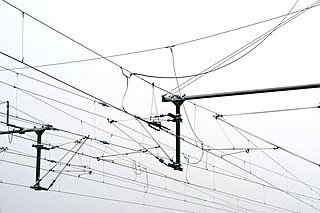
An overhead line or overhead wire is an electrical cable that is used to transmit electrical energy to electric locomotives, electric multiple units, trolleybuses or trams. The generic term used by the International Union of Railways for the technology is overhead line. It is known variously as overhead catenary, overhead contact line (OCL), overhead contact system (OCS), overhead equipment (OHE), overhead line equipment, overhead lines (OHL), overhead wiring (OHW), traction wire, and trolley wire.

Manchester Piccadilly is the main railway station of the city of Manchester, in the metropolitan county of Greater Manchester, England. Opened originally as Store Street in 1842, it was renamed Manchester London Road in 1847 and became Manchester Piccadilly in 1960. Located to the south-east of the city centre, it hosts long-distance intercity and cross-country services to national destinations including London, Birmingham, Nottingham, Glasgow, Edinburgh, Cardiff, Bristol, Exeter, Plymouth, Reading, Southampton and Bournemouth; regional services to destinations in Northern England including Liverpool, Leeds, Sheffield, Newcastle and York; and local commuter services around Greater Manchester. It is one of 19 major stations managed by Network Rail. The station has 14 platforms: 12 terminal and two through platforms. Piccadilly is also a major interchange with the Metrolink light rail system with two tram platforms in its undercroft.
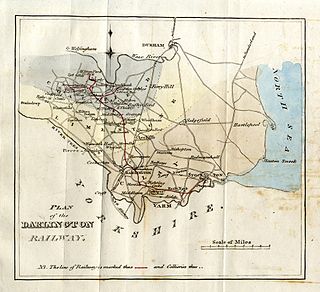
The Stockton and Darlington Railway (S&DR) was a railway company that operated in north-east England from 1825 to 1863. The world's first public railway to use steam locomotives, its first line connected collieries near Shildon with Darlington and Stockton in County Durham, and was officially opened on 27 September 1825. The movement of coal to ships rapidly became a lucrative business, and the line was soon extended to a new port at Middlesbrough. While coal waggons were hauled by steam locomotives from the start, passengers were carried in coaches drawn by horses until carriages hauled by steam locomotives were introduced in 1833.

An electric locomotive is a locomotive powered by electricity from overhead lines, a third rail or on-board energy storage such as a battery or a supercapacitor. Locomotives with on-board fuelled prime movers, such as diesel engines or gas turbines, are classed as diesel–electric or gas turbine–electric and not as electric locomotives, because the electric generator/motor combination serves only as a power transmission system.

The Dearne Valley line is the name given to a railway line in the north of England running from York to Sheffield via Pontefract Baghill and Moorthorpe. The route was built over several years and consists of lines built by several railway companies.

Manchester Central railway station was a railway station in Manchester city centre, England. One of Manchester's main railway terminals between 1880 and 1969, the building was converted into an exhibition and conference centre which was opened in 1986, originally known as G-MEX, but now named Manchester Central. The structure is a Grade II* listed building.

Sydney, the largest city in Australia, has an extensive network of passenger and goods railways. The first railway line in Sydney opened in 1855, becoming part of the Main Suburban railway line and laying the foundation for future expansion.
The Leeds and Selby Railway was an early British railway company and first mainline railway within Yorkshire. It was opened in 1834.
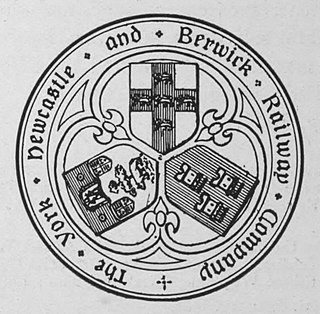
The York, Newcastle and Berwick Railway (YN&BR) was an English railway company formed in 1847 by the amalgamation of the York and Newcastle Railway as well as the Newcastle and Berwick Railway. Both companies were part of the group of business interests controlled by George Hudson, the so-called Railway King. In collaboration with the York and North Midland Railway and other lines he controlled, he planned that the YN&BR would form the major part of a continuous railway between London and Edinburgh. At this stage the London terminal was Euston Square and the route was through Normanton. This was the genesis of the East Coast Main Line, but much remained to be done before the present-day route was formed, and the London terminus was altered to King's Cross.

The Selby Diversion is a mainline railway in the United Kingdom, built as a new part of the East Coast Main Line (ECML) to avoid an area of potential subsidence over the newly discovered Selby Coalfield.

Holgate is a suburb of York in the ceremonial county of North Yorkshire, England. It is located about 1 mile west of Micklegate Bar in the city walls. Holgate is also the name of an electoral ward in the City of York unitary authority. The ward is currently bounded by the River Ouse from Scarborough Bridge to Ouse Acres on its northern boundary. Carr Lane and Ouse Acres on one side, and the intersection of York Road and Acomb Road on the other, make up its western boundary. The remainder of the southern boundary follows Moorgate and Holgate Beck to the East Coast Main Line railway which completes the eastern boundary as far as the River Ouse/Scarborough Bridge.
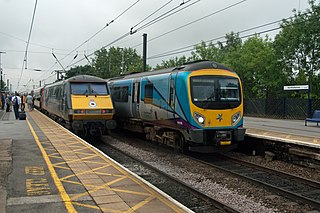
The network of railways in Northallerton, North Yorkshire, England, was constructed by three companies whose lines through the town were built between 1841 and 1852. They were all amalgamated into the North Eastern Railway (NER) which in turn was subsumed into the London and North Eastern Railway in 1923 and British Rail in 1948. British Rail closed two lines, the Wensleydale line in 1954 and a section of the Leeds Northern Railway to Harrogate in 1969. The Wensleydale line was retained as a freight branch and resurrected as a heritage railway in 2003 but the line to Harrogate closed completely. Despite closures and rationalisation, the station still is at a major junction on the East Coast Main Line.

The York and Doncaster branch was a railway line that opened in 1871 connecting Doncaster with York via Selby in Yorkshire, England. This line later became part of the East Coast Main Line (ECML) and was the route that express trains took between London King's Cross, the north of England and Scotland. It was opened by the North Eastern Railway (NER) between York and Shaftholme Junction, some 4.5 miles (7.2 km) north of Doncaster railway station. Between its opening in 1871 and the grouping in 1923, the line was used by both the NER, and the Great Northern Railway (GNR). All of the intermediate local stations that had opened with the line in 1871 closed down in the 1950s and 1960s leaving just Selby open between the town of Doncaster and the city of York.
Gallows Close goods yard was a freight transfer yard on the Scarborough and Whitby Railway in the town of Scarborough, North Yorkshire, England. The yard was opened in 1899 to relieve pressure on the main station in Scarborough and to release space for passenger use. After the Scarborough and Whitby Railway closed down, Gallows Close remained in use as a goods yard until final closure came in 1985.
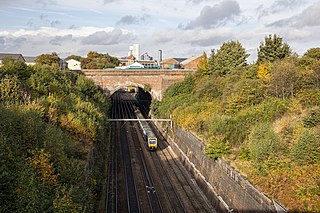
Richmond Hill Tunnel is a railway tunnel to the east of Leeds city centre, in West Yorkshire, England. The tunnel is known to be the first in the world specifically designed to carry passengers to be worked by steam trains rather than a stationary engine. One of the innovative methods employed to reassure passengers going through the lightless tunnel, was to place copper sheets underneath the air shafts which were intended to reflect the light around the tunnel. The original Richmond Hill Tunnel was 700 yards (640 m) long, but in 1894, it was widened into a cutting with a shorter tunnel, which is the existing structure in use today. The present Richmond Hill Tunnel is 118 yards (108 m) long, and is part of the longer Marsh Lane Cutting, which connects the eastward entrance and exit into Leeds railway station to the lines going towards Selby and York.

York Racecourse railway station, also known as York Holgate Excursion Platform and Holgate Bridge ticket platform, served Knavesmire Racecourse in Holgate, York, England, from 1860 to 1939 on the York and North Midland Railway.

Kilton Viaduct was a railway viaduct that straddled Kilton Beck, near to Loftus, in North Yorkshire, England. The viaduct was opened to traffic in 1867, however in 1911, with the viaduct suffering subsidence from the nearby ironstone mining, the whole structure was encased in waste material from the mines creating an embankment which re-opened fully to traffic in 1913. The railway closed in 1963, but then in 1974, it re-opened as part of the freight line to Boulby Mine carrying potash traffic.

Scarborough Bridge carries the railway line to Scarborough over the River Ouse in York, England. The first bridge was built in 1845, and has been renovated and rebuilt at least twice since its initial opening. A new bridge was installed in 2015 at a cost of £6 million. The first bridge had a pedestrian walkway which was located between the two running lines on the deck of the bridge, this was later moved to the east side of the bridge, and finally, in the 2010s rebuild, the walkway became a separate wider bridge. The bridge is still in daily use carrying Trans-Pennine services between Scarborough and either York, or Manchester and Liverpool.




















